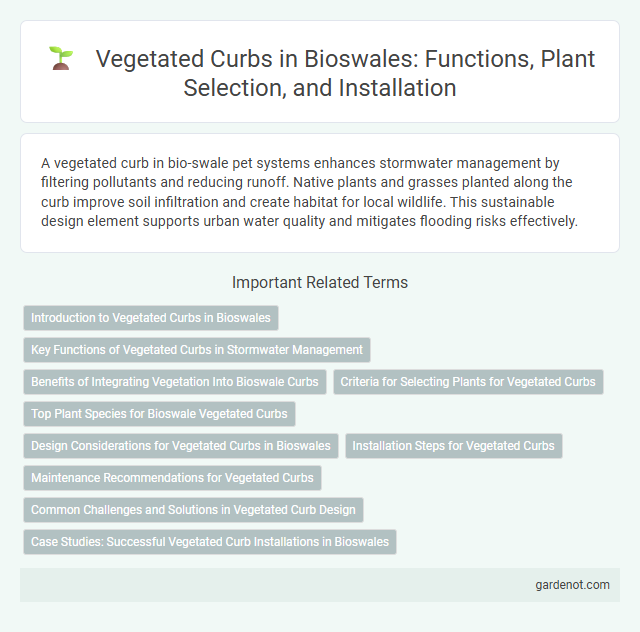A vegetated curb in bio-swale pet systems enhances stormwater management by filtering pollutants and reducing runoff. Native plants and grasses planted along the curb improve soil infiltration and create habitat for local wildlife. This sustainable design element supports urban water quality and mitigates flooding risks effectively.
Introduction to Vegetated Curbs in Bioswales
Vegetated curbs are integral components of bioswales designed to manage stormwater runoff by capturing and filtering pollutants through dense plantings and engineered soil media. These curb systems enhance urban water quality by promoting infiltration, reducing surface runoff velocity, and supporting biodiversity within green infrastructure networks. Implementing vegetated curbs in bioswales optimizes water management efficiency while contributing to sustainable urban landscape practices.
Key Functions of Vegetated Curbs in Stormwater Management
Vegetated curbs in stormwater management serve to capture and slow runoff, promoting infiltration and reducing surface water flooding. They filter pollutants such as sediments, heavy metals, and nutrients, improving water quality before it reaches larger drainage systems. These curbs also support groundwater recharge and enhance urban biodiversity by providing habitat for native vegetation.
Benefits of Integrating Vegetation Into Bioswale Curbs
Integrating vegetation into bioswale curbs enhances stormwater management by increasing infiltration and reducing runoff velocity, which minimizes erosion and pollutant transport. Vegetated curbs improve urban biodiversity by providing habitat for pollinators and beneficial insects, contributing to ecological health. Additionally, they enhance curb appeal and urban aesthetics while promoting temperature regulation through natural shading and evapotranspiration.
Criteria for Selecting Plants for Vegetated Curbs
Plants selected for vegetated curbs should exhibit strong drought tolerance and resilience to urban pollution to thrive in harsh roadside conditions. Native species with deep root systems are preferred for their ability to stabilize soil and enhance water infiltration in bio-swales. Selecting low-maintenance, salt-tolerant plants supports long-term sustainability and reduces the need for frequent irrigation and chemical treatments.
Top Plant Species for Bioswale Vegetated Curbs
Top plant species for bioswale vegetated curbs include native grasses such as Carex stricta (tussock sedge), Juncus effusus (soft rush), and Sporobolus heterolepis (prairie dropseed) due to their deep root systems that enhance soil infiltration and filtration. Herbaceous perennials like Echinacea purpurea (purple coneflower) and Asclepias tuberosa (butterfly milkweed) provide erosion control while supporting pollinator habitats. These species are selected for their drought tolerance, pollutant uptake capacity, and ability to thrive in fluctuating moisture conditions common in stormwater management systems.
Design Considerations for Vegetated Curbs in Bioswales
Design considerations for vegetated curbs in bioswales include selecting native, drought-tolerant plants that enhance infiltration and pollutant removal while requiring minimal maintenance. Proper grading and curb design ensure optimal water flow into the bioswale, preventing overflow and erosion. Incorporating appropriate soil media with high permeability and organic content supports healthy vegetation growth and maximizes stormwater treatment efficiency.
Installation Steps for Vegetated Curbs
Vegetated curb installation begins with site assessment to ensure proper slope and drainage functionality, followed by excavation to create a curb depression that accommodates soil and plants. Next, a high-quality, permeable soil mix is placed, and native, drought-tolerant vegetation is planted to enhance stormwater absorption and filtration. The final steps include installing an irrigation system if necessary and applying mulch to retain moisture and prevent erosion, promoting long-term sustainability of the bio-swale curb.
Maintenance Recommendations for Vegetated Curbs
Vegetated curbs require regular inspection to ensure plant health and structural integrity, with routine removal of debris and invasive species critical for optimal function. Irrigation schedules should be adjusted seasonally to maintain moisture without overwatering, while pruning promotes healthy growth and prevents obstruction of stormwater flow. Seasonal mulching and soil amendment support nutrient availability, enhancing plant resilience and overall curb longevity.
Common Challenges and Solutions in Vegetated Curb Design
Vegetated curbs often face challenges such as soil compaction, inadequate drainage, and plant selection difficulties that can affect stormwater management efficiency. Solutions include using engineered soil mixes to improve aeration, integrating permeable substrates for enhanced water infiltration, and selecting native, drought-tolerant plant species to ensure durability and low maintenance. Proper grading and incorporating overflow mechanisms also prevent waterlogging and structural damage, optimizing the vegetated curb's performance in urban landscapes.
Case Studies: Successful Vegetated Curb Installations in Bioswales
Case studies of vegetated curb installations in bioswales demonstrate significant improvements in stormwater management and urban runoff filtration. Locations like Portland, Oregon, and Seattle, Washington, report enhanced pollutant removal rates of up to 70% through strategic placement of native vegetation along curbs. These projects also highlight reduced flooding incidents and increased urban biodiversity, confirming vegetated curbs as effective green infrastructure components.
Vegetated curb Infographic

 gardenot.com
gardenot.com